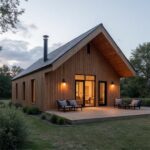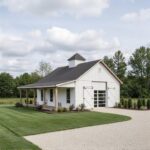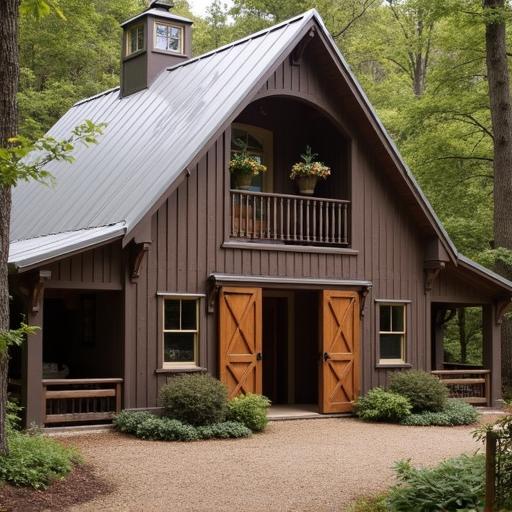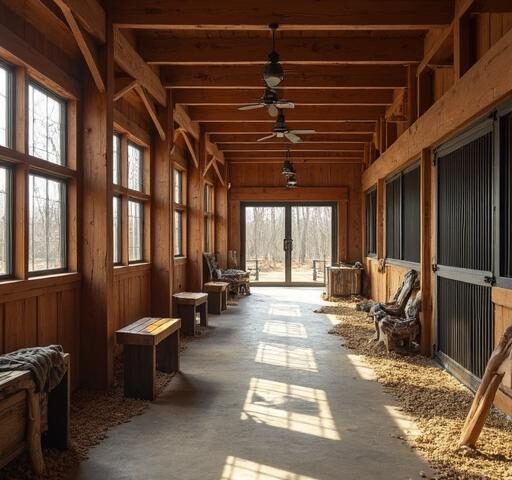
Prefab Barndominium: Embrace Modern Living Today
August 22, 2025
Barndominium Cost Per Square Foot: Discover Affordable Bliss
August 23, 2025Barndominium cost is changing the way people think about affordable housing options. As more individuals and families seek unique living spaces that combine rustic charm with contemporary conveniences, barndominiums are rapidly gaining popularity. Defined as hybrid structures that merge the traditional barn aesthetic with modern residential amenities, these homes offer a striking visual appeal alongside functionality. The rise in interest can be attributed not only to their distinctive design but also to their cost-effectiveness compared to conventional homes.
Barndominiums provide prospective homeowners with the opportunity to enjoy spacious interiors and customizable layouts without breaking the bank. Unlike standard houses that often require a hefty investment in both land and construction costs, barndominiums typically streamline expenses and maximize usable space while embracing a relaxed, open-plan living concept.
This trend resonates particularly well with those drawn to rural life or looking for alternatives in suburban settings. With an eye-catching exterior coupled with energy-efficient features, they have become a symbol of modern sustainable living.
As we delve deeper into understanding barndominium costs, it’s essential to explore the various factors influencing pricing decisions. From the materials used in construction to regional variations impacting labor rates and building codes, there are many elements at play that can alter initial budget expectations.
By painting a comprehensive picture of what goes into constructing these innovative homes, this article aims to equip potential homeowners with valuable insights that lead them closer to achieving their dreams of affordable yet stylish living through barndominiums.
Understanding Barndominium Costs
Factors Influencing Barndominium Costs
When considering the barndominium cost, several factors come into play that can significantly influence the final price tag of your dream home. One of the most significant determinants is the choice of materials used in construction. Whether you opt for steel framing, wood, or a combination thereof, each material has its own associated costs and benefits.
In addition to structural materials, exterior finishes like siding and roofing will add to your budget. Local availability can also affect costs; sourcing materials from further away can incur higher transportation fees.
Size is another crucial factor influencing overall costs. The square footage you desire will directly impact not only material needs but also labor expenses. Generally speaking, a larger barndominium means more materials for everything from foundations to roofing and internal fixtures, which inevitably raises the barndominium cost ceiling. Therefore, if you’re trying to stick to a budget, it’s essential to determine how much space you truly need versus what would be nice to have.
Location plays a pivotal role in shaping the financial parameters of your project as well. Construction costs can vary widely depending on where you choose to build your barndominium. Urban areas often present higher labor rates and stricter building codes that can complicate the construction process.
Conversely, rural locations may offer lower labor costs and more relaxed zoning regulations but could require additional investments in utility access like water or electricity. Understanding these regional differences can better equip potential homeowners with realistic expectations as they embark on their building journey.
General Price Range
To help set realistic expectations for prospective barndominium owners, it’s important to understand the general price range typically associated with these structures. On average, constructing a barndominium falls between $100 to $200 per square foot – though this figure may fluctuate based on factors discussed earlier. In some cases where premium materials or complex designs are employed, costs could skyrocket beyond this range.
Another consideration impacting barndominium cost is whether you’re purchasing an existing structure or starting from scratch on raw land. An existing barn that requires renovation might result in lower upfront costs compared to brand new construction but could entail hidden expenses such as repairs or redesigns needed for comfortable living spaces. By weighing these different scenarios carefully-along with understanding material quality-you’ll be more prepared when making decisions throughout your planning phase.
Ultimately, having clarity around what influences overall barndominium cost will empower potential homeowners as they navigate the complexities of budgeting for their future living space while ensuring that they make informed choices about their investment in affordable luxury housing options.
Breaking Down Construction Expenses
When embarking on the journey to construct a barndominium, it’s essential to understand the various construction expenses that will impact your overall budget. These expenses can be broadly categorized into several key components, each contributing significantly to the total barndominium cost.
The foundation is arguably one of the most critical aspects of any building project since it provides stability and support. Depending on soil conditions and design specifications, costs for foundations can vary widely, ranging from simple concrete slabs to more complex systems required for uneven terrain.
Once the foundation is in place, framing follows as another significant cost element in constructing a barndominium. This stage involves creating the structural framework of the home, which includes walls, windows, and roofing structures.
Costs can fluctuate based on the design choices made-whether opting for wood or steel framing-and labor expenses can differ vastly depending on location and contractor rates. Additionally, considering a modular kit versus custom framing could lead to substantial savings or allow for enhanced flexibility in design.
Roofing is another crucial expense that homeowners must consider during planning. Barndominiums often feature metal roofs that provide durability and aesthetic appeal but may come with higher initial costs compared to traditional shingles. However, these roofs are known for their longevity and low maintenance requirements, which can translate into long-term savings over time.
Lastly, interior finishes-which encompass everything from flooring to cabinetry-can greatly impact the overall barndominium cost as well. Choosing high-quality materials often improves functionality and aesthetics but doing so smartly allows homeowners to maintain budgetary constraints while still realizing their vision for an ideal space. By breaking down these core components of construction costs, potential barndominium owners can create a comprehensive budget while foreseeing where financial resources will be allocated most effectively.
Cost Variation by Location
Regional Pricing Influences
The cost of building a barndominium can vary significantly depending on the geographic location. Regional pricing influences stem from various factors, including local labor rates, availability of construction materials, and prevailing economic conditions. For instance, states with a higher cost of living may see elevated prices for both skilled labor and building materials. Conversely, rural areas often benefit from lower costs but may experience complications in obtaining certain supplies or skilled tradespeople due to their distance from urban centers.
When considering where to build your barndominium, it’s essential to research the local market dynamics thoroughly. Different states or regions might have specific regulations affecting construction costs, such as zoning laws and building codes that could add unforeseen expenses. Additionally, some areas may offer incentives for constructing energy-efficient homes which could further influence overall costs in a positive way.
Cost-Effective Locations for Barndominiums
If you’re looking for affordability in your barndominium project, several regions stand out as particularly favorable. Midwest states like Texas, Arkansas, and Indiana often present lower land acquisition costs and affordable building expenses compared to coastal states like California or New York. In these areas, trends indicate that the average barndominium cost can be reduced by taking advantage of locally sourced materials and labor while still achieving a modern lifestyle within this unique design approach.
Furthermore, when selecting a location for your barndominium, consider proximity to amenities such as schools, healthcare facilities, and shopping centers. While you might save on initial construction costs in more remote locations, ultimately these conveniences can impact long-term living expenses such as commute times and travel distances. Thus, achieving an optimal balance between initial investment and ongoing convenience is crucial for budgeting purposes.
Financing Your Barndominium
When it comes to financing your barndominium, understanding the various options available can help you make informed decisions that align with your budget. One popular route is obtaining a traditional mortgage. Many lenders are beginning to offer loans specifically for barndominiums due to their growing popularity.
When applying, it’s crucial to provide comprehensive details about the property, including plans and specifications, which can help ease the approval process. Ensure that your financial history reflects stability and reliability, as this can enhance your chances of securing favorable loan terms.

Another financing option worth considering is personal loans. Personal loans often feature a faster approval process compared to traditional mortgages and do not require the same level of collateral or extensive documentation. They can be particularly advantageous for those looking to cover initial costs associated with purchasing land or preparing it for construction. However, potential borrowers should weigh the higher interest rates associated with personal loans against their overall financial situation before proceeding.
Construction loans present another viable pathway for funding your barndominium project. These short-term loans are designed specifically for new builds and typically disburse funds in stages as construction progresses rather than providing a lump sum upfront.
This method enables homeowners to manage cash flow effectively while ensuring that funds are only released when construction milestones are achieved. While these loans can have slightly higher interest rates than traditional mortgages, they offer flexibility during the building phase, which many find beneficial in budgeting for additional expenses such as permits and inspections.
Considerations When Financing:
- Credit Score: A good credit score can help secure lower interest rates.
- Budget Planning: Assess all potential costs involved beyond just construction.
- Consulting Experts: Work with a realtor or financial advisor specializing in alternative housing options.
Each financing option has its own set of benefits and drawbacks; thus, it’s essential to choose one that best fits your financial circumstances while keeping future barndominium costs manageable.
Long-Term Savings and Energy Efficiency
Barndominiums not only offer an appealing aesthetic and spacious living arrangements, but they also promise significant long-term savings and enhanced energy efficiency. These unique homes are designed to leverage modern building techniques that reduce energy consumption, minimizing utility costs over time. With proper planning and the integration of sustainable features, homeowners can enjoy a lower cost of living without sacrificing comfort or style.
One major aspect contributing to this cost-effectiveness is the efficient use of insulation in barndominiums. Many builders utilize advanced insulation materials that greatly exceed the R-value standards set for traditional homes. By creating a thermal barrier, these materials keep indoor temperatures stable, reducing reliance on heating and cooling systems. Overall, this translates to:
- Lower monthly electricity bills
- Extended lifespan for HVAC systems
- Improved year-round comfort
In addition to superior insulation, barndominiums often incorporate energy-efficient windows and doors that further optimize heating and cooling needs. Homeowners may choose double or triple-pane glass options that resist heat loss during winter months while keeping interiors cool in summer. The integration of energy-efficient appliances and fixtures-such as LED lighting, Energy Star-rated products, and programmable thermostats-also contributes significantly to reducing overall energy consumption.
Furthermore, many who choose a barndominium lifestyle are interested in sustainable living methods such as solar panel installation. Utilizing renewable energy sources can decrease reliance on traditional power grids and lead to substantial savings on monthly utility expenses over time. Prospective homeowners should consider location-specific incentives available for going green-like tax credits or rebates-for making their barndominium even more affordable in the long run.
Hidden Costs to Consider
Building a barndominium is an exciting venture that combines rustic charm with modern convenience, but potential homeowners need to be aware of hidden costs that can significantly impact their overall budget. While the primary expenses, such as materials and labor, tend to be the focus of initial budgeting efforts, there are several additional costs that can sneak up on builders if they are not adequately planned for.
It is essential to take these factors into account to ensure a smooth construction process without unexpected financial setbacks.
One of the most overlooked elements in barndominium cost considerations is land preparation. Depending on the geographic location and current state of the land, this expense can vary widely. Clearing trees, grading the soil, or adding drainage systems can all add up quickly.
Additionally, obtaining necessary permits will also contribute to expenses; local governments typically require building permits and inspections throughout the various construction phases. It’s wise to consult local regulations early on in the planning process so you have a comprehensive understanding of what is needed and how much it might cost.
Utilities are another hidden cost that people frequently underestimate when planning to build a barndominium. Connecting electricity, water, and sewage services can come with hefty price tags depending on how far these utilities are from your property line.
Moreover, considering future upgrades or maintenance for these systems becomes crucial as well-especially if you’re aiming for energy efficiency with a more sustainable build. Ensuring access and establishing connections should not only be factored into your initial budget but should also be continuously monitored as your build progresses.
| Hidden Cost | Estimation Factors |
|---|---|
| Land Preparation | Soil condition, clearing trees, grading needs |
| Permitting Fees | Local government requirements |
| Utility Connections | Distance from utility lines & upgrade costs |
Tips for Cost-Effective Barndominium Planning
When planning for a barndominium, there are several strategies homeowners can implement to maximize their budget while achieving the home of their dreams. One of the most effective methods is to thoroughly research and choose cost-effective materials without sacrificing quality.
Opting for alternative building materials like metal siding or pre-engineered steel frames can significantly reduce costs compared to traditional wood construction. Additionally, shopping around for bulk material purchases or utilizing local suppliers can lead to substantial savings on expenses associated with items such as roofing, insulation, and interior finishes.
Another consideration when designing a barndominium is the layout and size of the space. Rather than opting for larger designs with complicated floor plans that often inflate barndominium cost, homeowners should focus on practicality and efficiency. An open-concept design not only maximizes space but also minimizes unnecessary walls and fixtures that escalate costs.
Simplifying architectural features and prioritizing essential components can help in streamlining expenses while still delivering an aesthetic appeal. Moreover, homeowners should consider incorporating multi-functional spaces that can serve dual purposes-such as a guest room doubling as an office-to further optimize both functionality and budget.
DIY projects also present excellent opportunities for saving money during the construction process. Homeowners who are willing to take on certain responsibilities-such as painting, landscaping, or even basic framing-can significantly reduce labor costs by performing these tasks themselves or enlisting the help of friends and family.
However, it’s crucial to recognize when hiring professionals might be more beneficial due to specific complexities involved in electrical work, plumbing, or structural engineering. A balanced approach between DIY efforts and professional services enables homeowners to maintain control over their budgets while ensuring safety and compliance with local building codes.
| Cost-Saving Strategy | Description |
|---|---|
| Choose Cost-Effective Materials | Opt for durable alternatives like metal siding which can lower overall construction costs. |
| Efficient Layout Design | Avoid complex layouts; use open-concept designs to reduce material needs. |
| Engage in DIY Projects | Tackle simpler tasks yourself to save on labor costs while hiring professionals for complex jobs. |
Conclusion
In conclusion, barndominiums present an enticing opportunity for those seeking a cost-effective and stylish solution to modern living. The unique combination of rustic barn aesthetics and contemporary amenities captures the imagination of many potential homeowners.
As we’ve explored throughout this article, understanding the various factors that influence barndominium cost is essential to making informed decisions. By considering aspects such as location, construction materials, and hidden expenses, prospective owners can embark on their journey toward building their dream home with confidence.
It’s crucial for future barndominium builders to recognize that while the initial investment can vary widely based on individual preferences and local market conditions, long-term savings can significantly affect overall affordability. With energy-efficient designs and clever planning, homeowners can reap benefits through lower utility bills and reduced maintenance costs over time.
Scrutinizing all facets from financing options to construction expenses ensures that individuals not only stay within budget but also fulfill their vision without compromising quality or comfort.
Ultimately, achieving your dream of a barndominium is possible through strategic planning and proactive engagement with professionals in the field. Whether it involves opting for DIY projects or selecting cost-efficient materials, every decision plays a role in minimizing expenses while maximizing enjoyment in your new space. Embrace the journey ahead; with patience and prudence, you will find yourself in a stunning abode that reflects both your lifestyle aspirations and financial goals.




